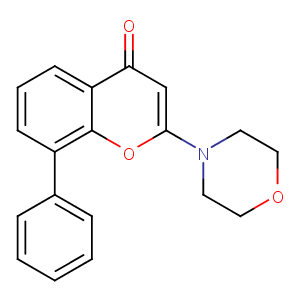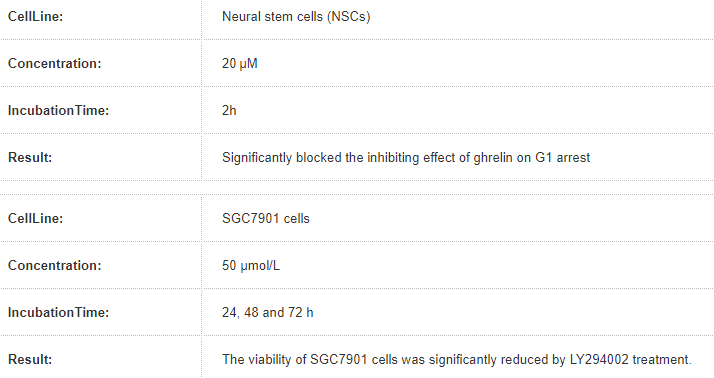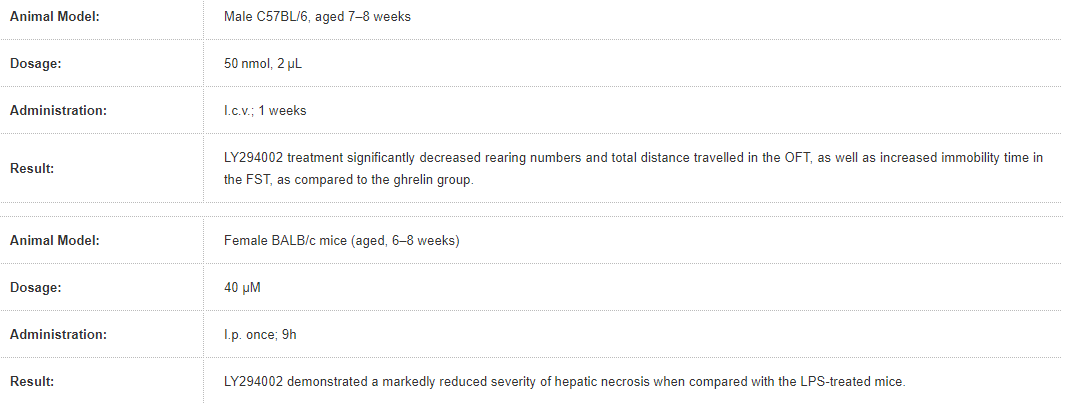



All products from TargetMol are for Research Use Only. Not for Human or Veterinary or Therapeutic Use.
Biological Description
Description: LY294002 is an inhibitor of PI3K (IC50s: 0.5/0.57/0.97 μM for PI3Kα/δ/β in cell-free assays). It also blocks autophagosome formation.
Targets&IC50: p110α:0.5 μM (cell free), DNA-PK:1.4 μM (cell free), p110δ:0.57 μM (cell free), p110β:0.97 μM (cell free)
In vitro: LY294002 (5 μM) was shown to block insulin-induced phosphorylation of PKB Ser473 in CHO-IR cells. When the cells were incubated in medium containing 20 μM LY294002 for 48 h, cell proliferation was remarkably decreased (>80%) in LoVo and Colo205 cells. LY294002 (10–50 μM), when added for 24 h, significantly decreased the population of DLD-1 cells in a concentration-dependent manner. When the cells were cultured in medium containing different concentrations of LY294002 (0, 10, 25, 50, and 75 μM)for 24 h and 48 h, cell proliferation was remarkably decreased in a dose-dependent fashion.

In vivo: The i.v. administration of LY294002 to mice in group A significantly suppressed the growth of s.c. tumors derived from both DLD-1 and LoVo cells, with a mean volume of 72% (range, 48–82%) and 55% (range, 40–61%), respectively. Treatment with LY294002 (50 mg/kg, 75 mg/kg) significantly reduced mean NPC tumor burden as compared with the control group. Treatment with 10 mg/kg or 25 mg/kg LY294002 was less effective in decreasing tumor burden.

Kinase Assay: PI3K inhibition by LY294002 was determined in a radiometric assay using purified, recombinant enzymes (class IA and class IB) with 1 μM ATP. The kinase reaction was carried out for 1 h at room temperature (24 °C) and was terminated by addition of PBS. IC50 values were subsequently determined using a sigmoidal dose-response curve fit (variable slope). CK2 and GSK3β (glycogen synthase kinase 3β) inhibition were established by kinase selectivity screening. Inhibitor (10 μM; LY294002) was tested against the Upstate panel of kinases in 10 μM ATP.
Cell Research: The cells were seeded into 96-well plates at 5000 cells/well. Twenty-four hours after cells were seeded, the medium was removed and replaced in the presence of LY294002 (0 μmol/L, 10 μmol/L, 25 μmol/L, 50 μmol/L, and 75 μmol/L) dissolved in DMSO or DMSO only for an additional 24 h and 48 h. To avoid any nonspecific toxic effects of DMSO on cell growth, DMSO concentrations were maintained at 0.5% in all experiments. MTT dye (5 mg/mL) was added to each well. The reaction was stopped by the addition of DMSO, and optical density was measured at 490 nm on a multiwell plate reader. Background absorbance of the medium in the absence of cells was subtracted. All samples were assayed in triplicate, and the mean for each experiment was calculated. Results were expressed as a percentage of control, which was considered to be 100%.
Animal Research: Athymic nude mice were used when they were 6-8 weeks. Mice were randomly divided into free separated into five groups (n = 4 mice). Mice were housed in the same environment with controlled temperature, humidity, and a 12 h light/dark cycle. Mice were inoculated subcutaneously with CNE-2Z cells (1 × 10^6 cells/mouse in 200 μl of RPMI-1640) into the flank. The tumor take rate was 100%. After 1 week, an intraperitoneal injection was performed to the xenograft mice with different dosage of LY294002 (10 mg/kg, 25 mg/kg, 50 mg/kg, and 75 mg/kg twice weekly (n = 4 mice), each group for 4 weeks. Treated mice have monitored any signs. Body weight and tumors size were measured twice a week. Tumor size was measured using calipers and tumor volume was calculated (volume = long axis × short axis^2). At the end of the treatment, all mice were euthanized. One part of tumor tissue was fixed in formalin and embedded in paraffin, and another part was stored at -70°C.
Chemical Properties
Molecular Weight: 307.349
Formula: C19H17NO3
CAS No.: 154447-36-6
Storage & Solubility Information
Storage
Powder: -20°C for 3 years
In solvent: -80°C for 2 years
Solubility Information
Ethanol: 10 mg/mL(32.5 mM)
H2O: <1 mg/mL
DMSO: 34 mg/mL (110.6 mM)
( < 1 mg/ml refers to the product slightly soluble or insoluble )
Catalog #: T2008
Please email us at cs@medikonia.com for any enquiry. To place an order, please include the catalog number(s) of the product(s) in the email.
References and Literature